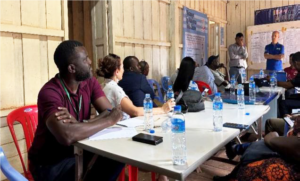 |
Dr. Rek JohnMBChB (MUST), MSc Epidemiology (LSHTM), FETP Graduate Host Site: National Malaria Elimination Division, Ministry of Health, UgandaHost Mentor:1. Dr. Jimmy Opigo, Dr. Catherine Maiteki |
||||||
ABOUT THE FELLOWI hold a Bachelor’s Degree in Medicine and Surgery – Mbarara University of Science and Technology and a Master’s in Epidemiology – London School of Hygiene and Tropical Medicine, University of London. With the Advanced FETP, I am now a well-grounded epidemiologist. My passion lies in supporting malaria elimination efforts, through innovative surveillance, data-driven strategies, and epidemiological practices. During the fellowship, I was attached to the National Malaria Control Division, now, the National Malaria Elimination Division (NMED). The NMED provides overall leadership for malaria control in Uganda. Through the in-service training at the NMED, I have attained great skills in leadership, outbreak investigation, and response including data analysis and interpretation, advocacy, multisectoral coordination, and engagement. Additionally, I Achievements at the Host Site
Fellowship program specific achievements
– Anthrax outbreak in Ibanda District, April 16 to 29, 2023 – Mpox outbreak in Mukono District, Kampala Metropolitan Area, October 30–November 9, 2024 – Mpox outbreak in Nakasongola District, Sept 30 to Oct 13, 2024
Summary of Epidemiological Study:Title: Multiple Complications in Patients Admitted with Severe Malaria in Epidemic Districts of Uganda, May to July 2023: An Epidemiological Study Background: Severe malaria, manifesting as a dysfunction of one or more organs, is a fatal form of malaria and is one of the leading causes of morbidity and mortality in Uganda. Between 2021 and 2023, Uganda experienced malaria epidemics in over 50 districts, resulting in high admissions and reported deaths. This study aimed to characterize severe malaria manifestations in hospitalized patients from the malaria epidemic districts in Uganda. Methods: We analyzed data from a line list of all patients hospitalized due to malaria in 27 high volume health facilities in 11 epidemic districts between May and July 2023. Patient demographics, clinical characteristics, pre-hospital treatments, severe malaria manifestation, and treatment outcomes were described as proportions. Using multivariable regression, we identified risk factors for multiple complications. Results: We line-listed 1,936 patients. The median age was 5 years (range 1-89), 54% (1,044) were <5 years old, and 51% (994) were females. The case fatality rate was 0.7% (14). Sickle cell anemia was the most common comorbidity in 77% (83/107) of patients with comorbidities. Most patients reported a fever (97%, 1,882), and 48% (924) had received pre-admission treatment for their symptoms. Unknown medicines accounted for the most pre-admission treatments received at 47% (550), in addition to oral paracetamol, 24% (281), and antimalarials 20% (236). Up to 75% (1443) of the patients had danger signs. 2,715 complications were reported80% (2,157) were in children <10 years, and 74% (2017) presented as ≥2 complications. The most common complications were low blood sugar, 22% (609), severe anemia, 19% (510), jaundice 12% (321), and blackwater fever 11% (306). Independent risk factors for multiple complications were age; <5 years [aOR=2.2, 95% CI=1.6-3.1] and 5≤15 [aOR=2.7, 95% CI=1.9-3.9]; having comorbidities [aOR=4.4, 95% CI=1.8-11]; and a danger sign of severe malaria at admission [aOR=10.1, 95% CI=7.6-13.5]. Conclusion: Multiple complications of malaria were common but mainly in children in the malaria epidemic settings. Younger age, comorbidities, and danger signs were predictors for multiple complications. Clinical teams must fully assess patients for all possible malaria complications for effective treatment. Key lessons learnt during the fellowship
|
|||||||
|
|
|
|
|
|
|
|
|






